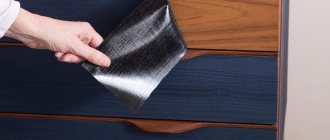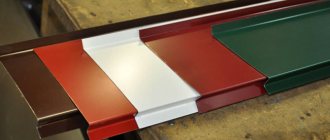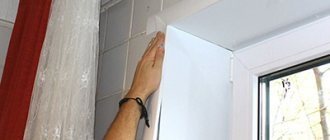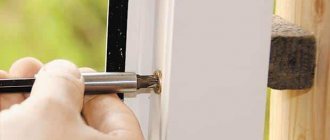Installing plastic windows always involves some hassle: you need to wash the glass, put things in order, and also remove the protective film. The last point, it would seem, does not require much effort, but in practice everything turns out to be more complicated. If you remove the film immediately after installation, it will yield easily and no problems will arise. But sometimes it is not possible to remove the protective layer immediately. Then, under the influence of sunlight and heat, it dries out, eats into the PVC and spoils the appearance.
But there is no need to despair and give up. It’s easy to remove dried film from frames, glass and window sills without damaging them if you know a few rules and tricks.
When to remove the coating from a profile: manufacturers' recommendations
Manufacturers warn to remove the protection layer from the profile after installation or within 10 days. Since it serves as armor for plastic, protecting it from dirt, minor scratches, and various damage during transportation, installation, and when performing finishing and construction work in the immediate vicinity of the window. It is not intended to remain on frames for a long time. Because the glue underneath dries and eats into the polymer material.
The sun protection layer itself will be damaged, lose elasticity, integrity, lose its technical characteristics, and it will be problematic to remove it.
The longer the tape covers structures, the more difficult it is to remove. Therefore, the main thing is to hurry up with the procedure, thereby significantly increasing the service life of the product.
Adviсe
Practical advice from experienced professionals will help speed up the cleaning process:
- If it is winter outside, frost can be a good helper in the process of removing the protective adhesive tape from the plastic window sill. It is enough to open the window for three to four hours and when the film on the plastic hardens thoroughly, just tear it off.
- When using a hairdryer to clean the window sill, it is better to direct the stream of hot air not at the film being torn off, but under it, as it is being torn off. Such actions will protect your hands from burns.
The protection from the new plastic window sill should be removed as soon as the installation of the window is completed. The longer the film covers the plastic, the stronger it bonds to the synthetic surface.
As a result, it is very difficult (and in some cases impossible) to completely clean the window sill from the protective layer.
How to remove film from plastic windows: safe for the surface
The protection is quickly removed on the day of installation of the structure. To do this, read the instructions and strictly follow all the points:
- Pry up the edge of the covering. On windows, start from the top corner for the side panels, and from any edge for the top trims. When cleaning the window sill, peel off the layer from the end. Use metal objects with caution to avoid damaging the surface and to avoid injuring your hands.
- Pull the raised edge down to the side. Carry out these actions with special care, trying to prevent the tape from breaking. If the glue is fresh, it will come off easily. In this case, it will be possible to remove entire fragments from all panels at once. Carry out the work wearing gloves, the material sticks to the skin of your hands.
- Wash the frame and window sill. Once the protective layer is removed, wipe the frame and window sill with a sponge or soft cloth, adding detergent to water. This will allow you to quickly remove the glue.
If the time to quickly remove the protective layer from the profile is lost, and the glue has dried, then you can use mechanical methods, folk remedies, and chemicals at home.
Why do you need film and when is the best time to remove it?
It should be immediately clear that the film coating on new plastic windows and window sills is not intended to protect them from mechanical influences throughout their entire service life. The film is used to protect the product only during transportation and installation. According to the recommendations, it is necessary to get rid of the protective coating immediately or within a short time after installing the window units.
If repair procedures are ongoing in the room, it is allowed to postpone this event a little, but it should not be delayed too much. And the point here is not that the packaging worsens the aesthetic characteristics of the window. The reason lies in the gradual drying of the glue, which can make cleaning much more difficult.
If you do not remove the protective film from the windows for a long time, the glue on it will dry out. In the future, it will not only be difficult to remove the film, but also to remove the glue stuck to the frame
The exact period during which the film still retains its pliability depends on several factors:
- Exposure to the sun. The glue can stay fresh the longest on the shady side of the house. In this case, even after six months, cleaning the window from the packaging usually does not cause difficulties: the film is removed easily and quickly. If the glass unit is illuminated by the sun most of the day, the film adhesive will evaporate within a week. After this, the frames and window sill can only be cleaned with special means.
- Air temperature. If windows are installed in the summer, then high air temperatures will contribute to the rapid drying of the adhesive between the film layer and the surface of the block. Accordingly, during the cold season, the protective coating retains its flexibility for removal longer.
- Quality of protective film. Unscrupulous companies producing plastic windows and accessories may use cheap material for packaging in order to save money. It is difficult to remove such film even immediately after installation work. As a rule, the cheaper the product, the greater the likelihood of encountering a similar problem. That is why it is recommended to give preference only to trusted manufacturers.
In order to clean the window from the packaging coating as quickly as possible, it is advisable to do it immediately after its installation. Even if protection is necessary during subsequent repair work (for example, for arranging slopes), you can use masking tape for this - removing it usually does not cause any difficulties.
There are several ways to remove protective film from a plastic window or window sill. The choice of a specific option depends on how tightly the packaging holds.
How to get rid of sticky coating using traditional methods
Folk remedies will allow you to safely clean the frames and enjoy the results.
Vegetable oil
A good solution would be to take vegetable oil. Apply the product to the stained area using a cotton swab and wait 1 hour. As the oil dries, lubricate the surface systematically. Clean with a paper towel and rinse with a non-abrasive cleaning solution.
Soap solution
A wide range of household chemicals allows you to wash the protective layer. To do this, take soap, dissolve it in warm water, and soften the entire profile area with a sponge.
If the packaging is held firmly, then resort to mechanical methods.
How to remove film mechanically
It is easy to remove the layer immediately after installation. But after a few months, this process becomes much more complicated. There are mechanical ways to safely remove tape from the surface of enclosing structures, including:
Scraper, stiff brush
An effective option, but if you act carelessly there is a high probability of leaving scratches.
Therefore, it is important to do it as follows:
- Using a scraper, pry up the edge of the old polymer material and slowly pull it towards yourself, trying to tear it off with a sharp movement.
- If the tape begins to tear, pry it again, trying to use a sharp tool less often, and work as much as possible with your fingers.
- A brush is necessary to get rid of glue. It is important to soak it in a soap solution and wipe the surface.
This option is effective if the coating has not dried out and has not yet become damaged under the influence of ultraviolet radiation.
Household, construction hair dryer
It is proposed to use a construction hair dryer, since it will be more difficult for ordinary ones to achieve a positive result due to lack of power.
The process consists of performing certain steps:
- Turn on the device, concentrate the flow of hot air onto the window, maintaining a distance of 35-40 cm, to avoid deformation of the structure.
- When the dried layer warms up enough and softens, lift it by the edge and remove it.
- Wipe the surface with a hard cloth soaked in acetone.
Initially, manufacturers recommend trying to deal with the problem mechanically. If it cannot be removed, then resort to aggressive chemical solvents.
Stationery tape
Transparent tape with a width of at least 50 mm is suitable for work. Separate a 70 mm long strip from it, stick it over the dried area, press it carefully, smooth it out, wait about 2 minutes, then peel it off quickly.
School eraser
You can erase stuck glue with a white eraser. Then wash the frames with soap and water.
This method cannot be used if the profile is colored; streaks may appear.
Nail polish remover
The cosmetic composition easily isolates the protection layer and glue from the plastic after repairs are completed. It is necessary to apply the liquid to gauze cloth and process the polymer material.
Heat
You can also remove the old film by heating it. The best result will be achieved if you combine heating of the protective layer with its removal with a scraper. You can create the necessary conditions with any tool that increases the temperature without coming into contact with the surface. A steam generator and hair dryer are great for this.
Steam generator
The steam generator copes with removing film not only from the window sill and frames, but also from glass. Procedure:
- Connect the device to the network.
- Place it at a distance of 30-35 cm from the window, but if the film needs to be removed from the glass, it is recommended to keep the steam generator no closer than 15-20 cm.
- Point at the corner of the film.
- Wait until the coating softens.
- Remove it by prying it with something sharp or rubbing it with a stiff brush dipped in solvent.
Attention! Follow safety rules to avoid getting burned. Do not bring the steam generator closer than 30 cm to the window, otherwise the plastic may begin to melt. If we are talking about glass, place the equipment at a distance of about 15 cm.
Removing the film with a hairdryer is a little more difficult, since it supplies dry air, not wet air, like a steam generator.
How to remove dried protective film with solvents
The protective layer will dry out after a year, and it will not be possible to get rid of it without using chemicals. They will also help remove sticky yellowish stains without leaving a trace. It is important to be careful when using aggressive compounds with abrasive bases. Do not apply little-known or untested chemical products. For personal protection, use gloves and a respirator.
Medical alcohol
Alcohol can easily clean, as well as lighten plastic and rid it of all kinds of contaminants.
The process consists of the following steps:
- Send the alcohol into a spray bottle or apply it to a soft cloth or cotton wool.
- Go through problem areas. As soon as the alcohol dries, repeat the procedure.
- Continue for 5-10 minutes. Then remove the stuck layer using a paper towel.
This option is simple, effective and will not disturb the window. The process takes a minimum of time and financial costs.
White Spirit
White spirit can ruin plastic. Therefore, before carrying out the procedure, make sure that the polymer is resistant to solvents.
To do this, apply a little chemical product to a barely noticeable area. If the appearance of the plastic has not changed, then you can safely get to work:
- Pry the edge of the tape and peel it off the surface.
- Pour white spirit into the space that appears. It is not recommended to apply it on top, it will not give a positive effect.
- Wait 3-5 minutes, during this period the solvent will be absorbed into the structure of the material and corrode the hardened composition.
- Carefully remove the annoying tape and clean off the adhesive.
If necessary, reapply White Spirit.
Detergent Shumanit
This effective product is versatile; its main focus is removing grease from kitchen utensils and devices. Also works great with glue.
Principle of using Schumanite:
- Treat the glue with the preparation. If you need to peel off the old coating, apply the liquid to the area underneath and to the edges along the length of the tape.
- After application, discard the layer and remove the remaining glue with a towel soaked in water.
- Wash the plastic with clean water and wipe dry.
Schumanite contains caustic components, so you should not hold it for more than 3 minutes to avoid damaging the polymer material.
HG Sticker Remover
This drug is used to remove stickers and stickers. But in practice, this is the optimal solution to remove old dried film.
Application technology of HG Sticker Remover:
- Separate the coating with a knife or blade.
- Process the panels under the forgotten tape.
- After 3-5 minutes, remove the protective layer.
- Apply the product again and wait 3-5 seconds, wipe with a clean cloth.
This method allows you to quickly clean plastic windows. The only drawback is the high cost of production.
Cosmofen 10
It is a liquid material with the addition of a solvent for cleaning frames. Before the procedure, try to peel off the coating and treat the problematic panels in accordance with the instructions, rinse with soapy water and treat with polish to eliminate micro-scratches and add shine. Using this method you can get rid of the glue after a few years.
Window Care Guide
Fresh stains can be easily washed with soapy water. But to get rid of older and stubborn ones, you will have to use chemical household cleaning products.
Important : wash the window sill with a foam sponge or rag. Microfiber products that are now popular are also suitable. Do not use hard brushes or metal wire brushes, which can scratch the material, causing irreparable damage to it.
Stages of cleaning metal-plastic window structures:
- The approach must be rational. It is unwise to wash the window sill, and then the frames and glass, because all the dirt from them will flow down and you will have to redo the work already done.
- Initially, the horizontal surface is wiped with a dry cloth to remove dust and light debris. As a last resort, you can use a broom or soft brush to sweep away the excess. Only then do wet cleaning begin.
- Depending on the reason for cleaning (yellowing, stains, consequences of repair or installation of the windows themselves), they switch to the use of special industrial products or folk methods to combat pollution. The composition is not applied to the window sill itself - only to the element used for cleaning.
- The surface can be different: glossy, matte, porous and rough. If a fleece rag is enough for a smooth surface, then the maximum you can use on a textured one is a sponge. And you will have to try hard to wipe off even stubborn dust without any additional means. To combat dirt in hard-to-reach places, use an old toothbrush with soft bristles.
- Use a cloth or sponge to make light circular movements, concentrating on the most problematic areas. After achieving the desired result, the window sill should be rinsed with clean water and wiped dry. Leaving the product wet means negating your own work, as dust will stick again.
The longer an event is postponed, the more contaminants become absorbed and the more difficult it is to wash them off.
How to remove film from a windowsill
To clean the window sill, use the same methods as for the frame. An excellent solution would be to take Admiral, which is produced for PVC surfaces.
Procedure:
- wet the window sill;
- apply the composition, leave for 5-7 minutes;
- take a scraper and remove the old film with it.
It is important to remove the coating in a timely manner; this will help to avoid wasted time and labor costs for unnecessary manipulations. Otherwise, you will have to use aggressive compounds, and the consequences of this process are difficult to predict. Scratches and deformation are a particular result of risky methods.











